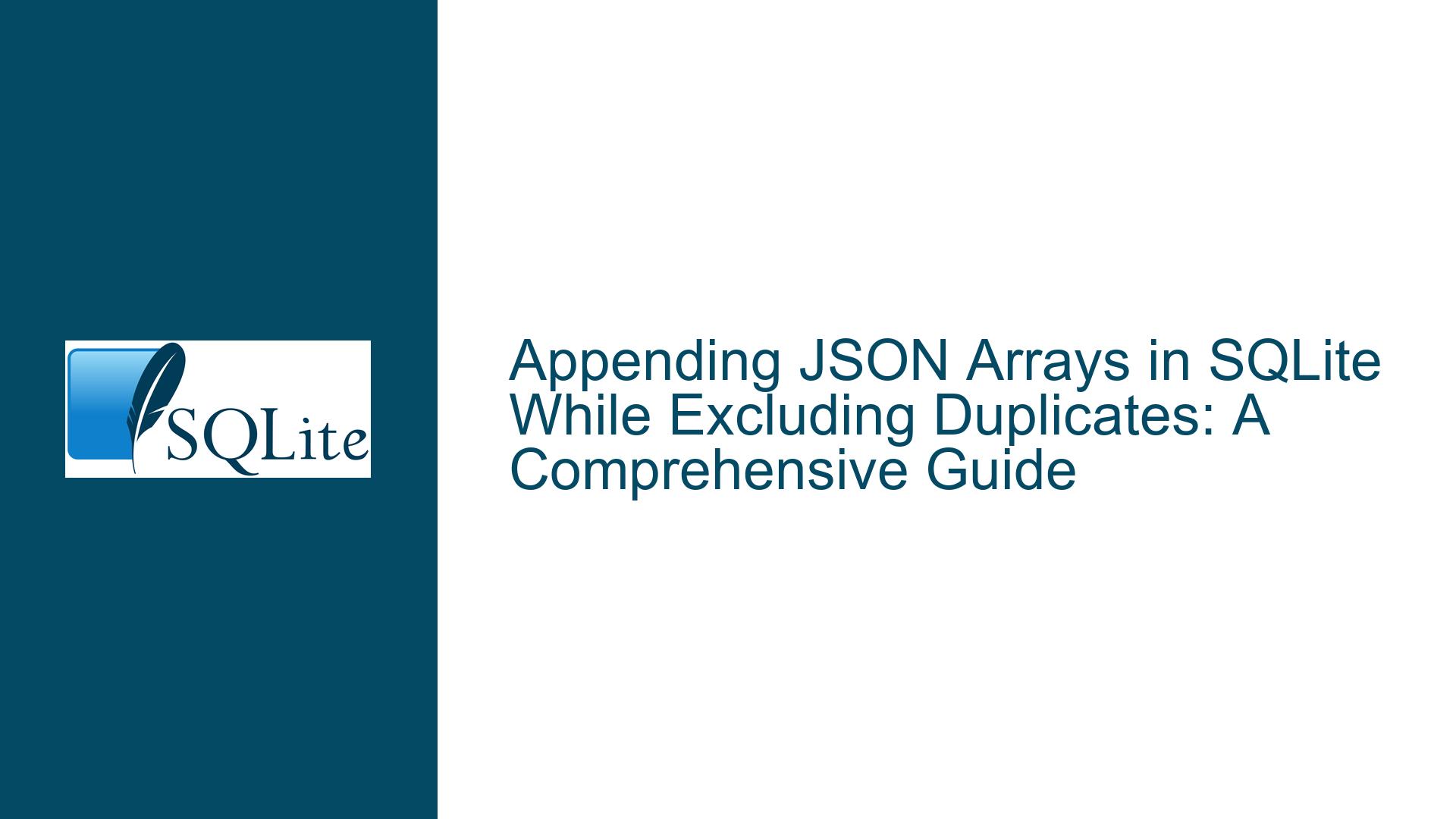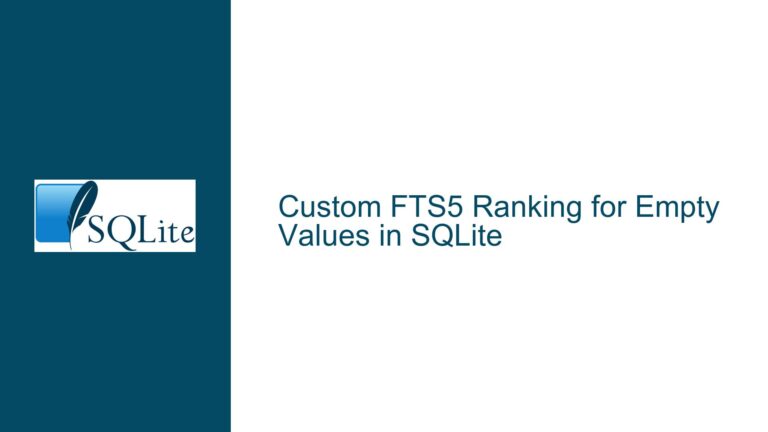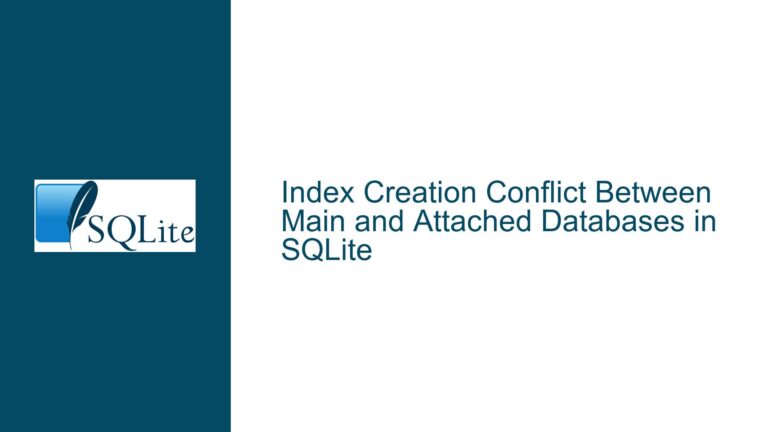Appending JSON Arrays in SQLite While Excluding Duplicates: A Comprehensive Guide
Understanding the Problem: Merging JSON Arrays Without Duplicates
The core issue revolves around merging two JSON arrays in SQLite while ensuring that no duplicate values are introduced into the resulting array. This is a common scenario when dealing with JSON data in databases, especially when updating existing JSON structures with new data. The challenge lies in efficiently combining the arrays, preserving the order, and ensuring that the operation is performant, particularly when dealing with large datasets.
In the provided examples, the user attempts to merge JSON arrays stored in a table called existing_data with new JSON arrays provided in a temporary table or CTE (Common Table Expression) called new_data. The goal is to update the state column in existing_data by appending the new array elements while excluding any duplicates. The user presents two initial attempts, both of which achieve the desired result but are deemed overly complex. A third, more compact solution is later proposed, leveraging SQLite’s built-in JSON functions and even introducing a custom User-Defined Function (UDF) for further simplification.
Exploring the Root Causes of Complexity in JSON Array Merging
The complexity in merging JSON arrays in SQLite stems from several factors. First, SQLite’s JSON support, while powerful, is not as extensive as that of some other databases. It lacks native functions specifically designed for merging JSON arrays while excluding duplicates. This forces developers to rely on a combination of JSON functions (json_set, json_extract, json_group_array, etc.) and standard SQL operations to achieve the desired result.
Second, JSON arrays are inherently unstructured within the context of SQL. While SQLite provides functions to parse and manipulate JSON, these operations often require intermediate steps, such as extracting array elements, performing joins or unions, and then reassembling the array. This can lead to verbose and complex queries, as seen in the initial attempts.
Third, the need to preserve order and exclude duplicates adds another layer of complexity. Ensuring that the merged array maintains the correct sequence of elements while avoiding duplicates requires careful handling of the data, often involving subqueries, virtual tables, and temporary structures.
Finally, performance considerations come into play, especially when dealing with large JSON arrays. The efficiency of the merging operation can vary significantly depending on the approach taken. For instance, using virtual tables to iterate over JSON elements can be slower than leveraging built-in functions or custom UDFs.
Step-by-Step Solutions for Efficient JSON Array Merging
Solution 1: Using Built-In JSON Functions
The first solution involves using SQLite’s built-in JSON functions to merge the arrays while excluding duplicates. Here’s a breakdown of the steps:
Extract the Existing and New Arrays: Use
json_extractto retrieve the existing array fromexisting_dataand the new array fromnew_data.Combine the Arrays: Use
json_arrayto create a new JSON array that contains both the existing and new arrays.Flatten the Combined Array: Use
json_treeto flatten the combined array into individual elements. This function recursively traverses the JSON structure and returns each element along with its path.Filter Out Duplicates: Use a
SELECTstatement withDISTINCTto ensure that only unique values are included in the final array.Reassemble the Array: Use
json_group_arrayto reassemble the filtered elements into a single JSON array.Update the Original Data: Use
json_setto update thestatecolumn inexisting_datawith the newly merged array.
Here’s the complete query:
WITH
new_data(key, state) AS (
VALUES (1, '{"d":[2,4,5,6,8]}')
)
UPDATE existing_data AS e
SET state = json_set(e.state, '$.d',
(SELECT json_group_array(DISTINCT value)
FROM json_tree(json_array(e.state->'$.d', n.state->'$.d'))
WHERE path <> '$')
)
FROM new_data n
WHERE n.key = e.key;
This approach is more compact and leverages SQLite’s JSON functions effectively. However, it still involves multiple steps and may not be the most performant solution for very large arrays.
Solution 2: Using a Custom User-Defined Function (UDF)
For those who need a more efficient and reusable solution, creating a custom UDF in SQLite can be a game-changer. The UDF, named json_array_merge, takes two JSON arrays as input, merges them while excluding duplicates, and returns the resulting array.
Define the UDF: The UDF is implemented in C and registered with SQLite using the
sqlite3_create_functionAPI. The function takes two JSON arrays as input, merges them, and ensures that no duplicates are present in the final array.Load the UDF: Use the
.loadcommand in SQLite to load the UDF from the shared library.Use the UDF in Queries: Once loaded, the UDF can be used directly in SQL queries to merge JSON arrays.
Here’s the C code for the UDF:
#include "sqlite3ext.h"
SQLITE_EXTENSION_INIT1
#include <string.h>
static void jsonArrayMergeFunc(
sqlite3_context *context,
int argc,
sqlite3_value **argv
){
const char *arr1 = (const char*)sqlite3_value_text(argv[0]);
const char *arr2 = (const char*)sqlite3_value_text(argv[1]);
int arr1_len = sqlite3_value_bytes(argv[0]);
int arr2_len = sqlite3_value_bytes(argv[1]);
char *res;
int res_pos;
int i, j;
int element_len;
int element_exists;
if(arr1_len+arr2_len == 0){
sqlite3_result_text(context, "[]", -1, SQLITE_STATIC);
return;
}
res = sqlite3_malloc(arr1_len+arr2_len);
if( !res ){
sqlite3_result_error_nomem(context);
return;
}
memcpy(res, arr1, arr1_len);
if(arr1_len == 0){
res[0] = '[';
res_pos = 1;
}else{
res_pos = arr1_len-1;
}
element_len = 0;
for(i=1; i<arr2_len; i++){
if(arr2[i] != ',' && arr2[i] != ']'){
element_len++;
}else{
element_exists = 0;
for(j=0; j<res_pos; j++){
if((res[j] == ',' || j == 0)
&& (res[j+element_len+1] == ',' || j+element_len+1 >= res_pos )
&& memcmp(&res[j+1], &arr2[i-element_len], element_len) == 0){
element_exists = 1;
break;
}
}
if( element_exists == 0 && element_len != 0 ){
if(res_pos > 1)
res[res_pos++] = ',';
memcpy(&res[res_pos], &arr2[i-element_len], element_len);
res_pos += element_len;
}
element_len = 0;
}
}
res[res_pos++] = ']';
sqlite3_result_text(context, res, res_pos, sqlite3_free);
}
#ifdef _WIN32
__declspec(dllexport)
#endif
int sqlite3_jsonarraymerge_init(
sqlite3 *db,
char **pzErrMsg,
const sqlite3_api_routines *pApi
){
int rc = SQLITE_OK;
SQLITE_EXTENSION_INIT2(pApi);
(void)pzErrMsg; /* Unused parameter */
rc = sqlite3_create_function(db, "json_array_merge", 2,
SQLITE_DETERMINISTIC|SQLITE_INNOCUOUS|SQLITE_UTF8, 0,
jsonArrayMergeFunc, 0, 0);
return rc;
}
Once the UDF is loaded, the query to merge JSON arrays becomes much simpler:
.load json_array_merge
WITH
new_data(key, state) AS (
VALUES (1, '{"d":[2,4,5,6,8]}')
)
UPDATE existing_data AS e
SET state = json_set(e.state, '$.d', json_array_merge(e.state->'$.d', n.state->'$.d'))
FROM new_data n
WHERE n.key = e.key;
This approach is not only more efficient but also more readable and maintainable. It abstracts away the complexity of merging JSON arrays into a single function call, making it easier to use in various contexts.
Solution 3: Optimizing for Large JSON Arrays
For scenarios where the JSON arrays are particularly large, performance becomes a critical concern. In such cases, it’s important to minimize the number of operations and avoid unnecessary parsing of JSON data.
Pre-Filter New Data: Before merging, filter out any elements in the new array that already exist in the existing array. This reduces the amount of data that needs to be processed.
Use Efficient Data Structures: If possible, use temporary tables or in-memory structures to store intermediate results. This can help avoid repeated parsing of JSON data.
Batch Processing: If dealing with extremely large arrays, consider processing the data in smaller batches to avoid memory issues and improve performance.
Here’s an example of how to pre-filter new data:
WITH
new_data(key, state) AS (
VALUES (1, '{"d":[2,4,5,6,8]}')
),
filtered_data AS (
SELECT jn.value
FROM json_each((SELECT json_extract(state, '$.d') FROM new_data)) jn
LEFT JOIN json_each((SELECT json_extract(state, '$.d') FROM existing_data WHERE key = 1)) je
ON jn.value = je.value
WHERE je.value IS NULL
)
UPDATE existing_data AS e
SET state = json_set(e.state, '$.d',
json(rtrim(json_extract(e.state, '$.d'), ']') || ',' || substr(json_group_array(value), 2))
)
FROM filtered_data
WHERE e.key = (SELECT key FROM new_data);
This approach ensures that only new, non-duplicate elements are added to the existing array, reducing the complexity and improving performance.
Conclusion
Merging JSON arrays in SQLite while excluding duplicates can be challenging, but with the right approach, it’s entirely feasible. By leveraging SQLite’s built-in JSON functions, creating custom UDFs, and optimizing for performance, you can efficiently handle this task. Whether you’re dealing with small arrays or large datasets, the solutions outlined above provide a comprehensive guide to achieving your goals.






